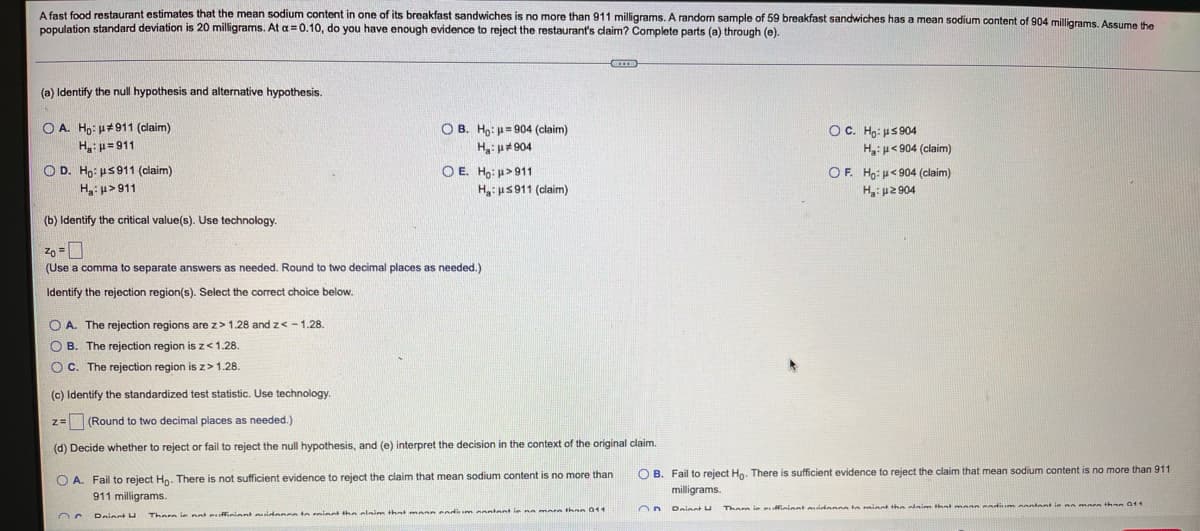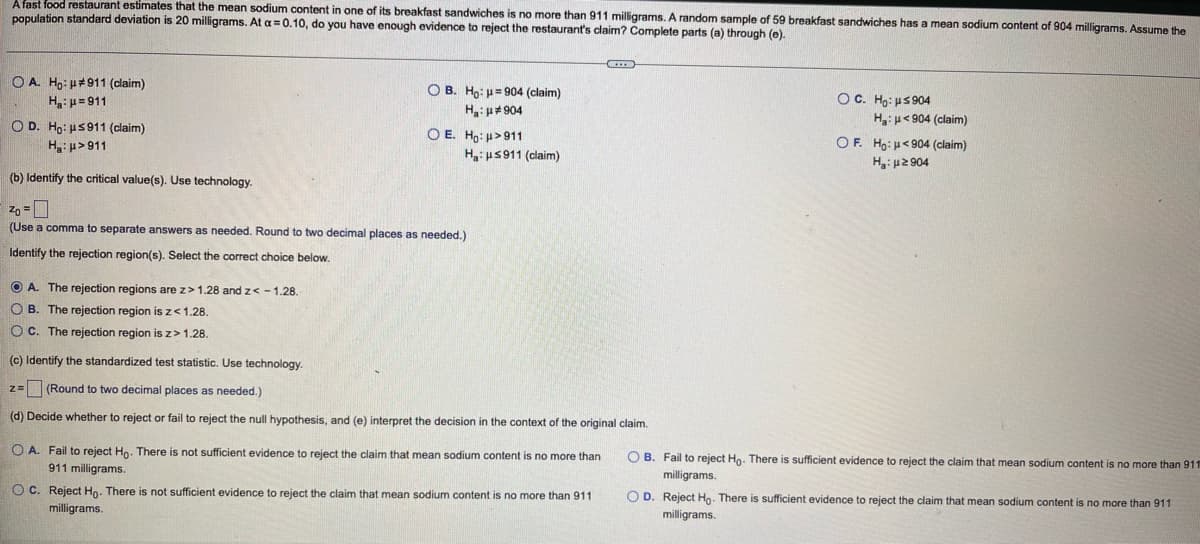A fast food restaurant estimates that the mean sodium content in one of its breakfast sandwiches is no more than 911 milligrams. A random sample of 59 breakfast sandwiches has a mean sodium content of 904 milligrams, Assume tbe pOpulation standard deviation is 20 milligrams. At a= 0.10, do you have enough evidence to reject the restaurant's claim? Complete parts (a) through (e). (a) Identify the null hypothesis and alternative hypothesis. OA. Ho: H#911 (claim) H p=911 O D. Ho: us911 (claim) H:p>911 O B. Ho: p=904 (claim) OC. Ho: us904 H: u#904 H:u< 904 (claim) O E. Ho: u>911 OF. Ho: u< 904 (claim) H:us911 (dlaim) H: p2 904 (b) Identify the critical value(s). Use technology. (Use a comma to separate answers as needed. Round to two decimal places as needed.) Identify the rejection region(s). Select the correct choice below. O A. The rejection regions are z>1.28 and z< -1.28. O B. The rejection region is z<1.28. O C. The rejection region is z>1.28. (c) Identify the standardized test statistic. Use technology. z= (Round to two decimal places as needed.) (d) Decide whether to reject or fail to reject the null hypothesis, and (e) interpret the decision in the context of the original claim. O B. Fail to reject Ho. There is sufficient evidence to reject the claim that mean sodium content is no more than 911 milligrams. O A. Fail to reject Ho. There is not sufficient evidence to reject the claim that mean sodium content is no more than 911 milligrams.
A fast food restaurant estimates that the mean sodium content in one of its breakfast sandwiches is no more than 911 milligrams. A random sample of 59 breakfast sandwiches has a mean sodium content of 904 milligrams, Assume tbe pOpulation standard deviation is 20 milligrams. At a= 0.10, do you have enough evidence to reject the restaurant's claim? Complete parts (a) through (e). (a) Identify the null hypothesis and alternative hypothesis. OA. Ho: H#911 (claim) H p=911 O D. Ho: us911 (claim) H:p>911 O B. Ho: p=904 (claim) OC. Ho: us904 H: u#904 H:u< 904 (claim) O E. Ho: u>911 OF. Ho: u< 904 (claim) H:us911 (dlaim) H: p2 904 (b) Identify the critical value(s). Use technology. (Use a comma to separate answers as needed. Round to two decimal places as needed.) Identify the rejection region(s). Select the correct choice below. O A. The rejection regions are z>1.28 and z< -1.28. O B. The rejection region is z<1.28. O C. The rejection region is z>1.28. (c) Identify the standardized test statistic. Use technology. z= (Round to two decimal places as needed.) (d) Decide whether to reject or fail to reject the null hypothesis, and (e) interpret the decision in the context of the original claim. O B. Fail to reject Ho. There is sufficient evidence to reject the claim that mean sodium content is no more than 911 milligrams. O A. Fail to reject Ho. There is not sufficient evidence to reject the claim that mean sodium content is no more than 911 milligrams.
MATLAB: An Introduction with Applications
6th Edition
ISBN:9781119256830
Author:Amos Gilat
Publisher:Amos Gilat
Chapter1: Starting With Matlab
Section: Chapter Questions
Problem 1P
Related questions
Question

Transcribed Image Text:A fast food restaurant estimates that the mean sodium content in one of its breakfast sandwiches is no more than 911 milligrams. A random sample of 59 breakfast sandwiches has a mean sodium content of 904 milligrams. Assume the
pOpulation standard deviation is 20 milligrams. At a = 0.10, do you have enough evidence to reject the restaurant's claim? Complete parts (a) through (e).
(a) Identify the null hypothesis and alternative hypothesis.
O A. Ho: u#911 (claim)
H p= 911
O D. Ho: us911 (claim)
H: u> 911
O B. Ho: p= 904 (claim)
OC. Ho: us 904
H: u#904
H: u<904 (claim)
O E. Ho: p>911
OF. Ho: p< 904 (claim)
Ha:us911 (claim)
H: p2 904
(b) Identify the critical value(s). Use technology.
(Use a comma to separate answers as needed. Round to two decimal places as needed.)
Identify the rejection region(s). Select the correct choice below.
O A. The rejection regions are z>1.28 and z< -1.28.
O B. The rejection region is z<1.28.
O C. The rejection region is z>1.28.
(c) Identify the standardized test statistic. Use technology.
z= (Round to two decimal places as needed.)
(d) Decide whether to reject or fail to reject the null hypothesis, and (e) interpret the decision in the context of the original claim.
O A. Fail to reject Ho. There is not sufficient evidence to reject the claim that mean sodium content is no more than
911 milligrams.
O B. Fail to reject Ho. There is sufficient evidence to reject the claim that mean sodium content is no more than 911
milligrams.
Dainnt u
Thare ie efiniont aidenee ta reinct the alaim that man eadium nantent ie na more than a11
Roiect H
There ie nat euffininnt idance to ninnt the nlnim that monn endim aantant ie na marn than 011

Transcribed Image Text:A fast food restaurant estimates that the mean sodium content in one of its breakfast sandwiches is no more than 911 milligrams. A random sample of 59 breakfast sandwiches has a mean sodium content of 904 milligrams. Assume the
population standard deviation is 20 milligrams. At a =0.10, do you have enough evidence to reject the restaurant's claim? Complete parts (a) through (e).
O A. Ho: u#911 (claim)
O B. Ho: = 904 (claim)
H: u= 911
OC. Hg: us 904
Hg: u#904
H: u< 904 (claim)
O D. Ho: us911 (claim)
H: u> 911
O E. Ho: >911
OF. Ho: u< 904 (claim)
H: p2 904
H:us911 (claim)
(b) Identify the critical value(s). Use technology.
(Use a comma to separate answers as needed. Round to two decimal places as needed.)
Identify the rejection region(s). Select the correct choice below.
O A. The rejection regions are z>1.28 and z< - 1.28.
O B. The rejection region is z<1.28.
O C. The rejection region is z> 1.28.
(c) Identify the standardized test statistic. Use technology.
z= (Round to two decimal places as needed.)
(d) Decide whether to reject or fail to reject the null hypothesis, and (e) interpret the decision in the context of the original claim.
O A. Fail to reject Ho. There is not sufficient evidence to reject the claim that mean sodium content is no more than
911 milligrams.
O B. Fail to reject Ho. There is sufficient evidence to reject the claim that mean
content is no more than 911
milligrams.
O C. Reject Ho. There is not sufficient evidence to reject the claim that mean sodium content is no more than 911
O D. Reject Ho. There is sufficient evidence to reject the claim that mean sodium content is no more than 911
milligrams.
milligrams.
Expert Solution
This question has been solved!
Explore an expertly crafted, step-by-step solution for a thorough understanding of key concepts.
Step by step
Solved in 3 steps with 3 images

Recommended textbooks for you

MATLAB: An Introduction with Applications
Statistics
ISBN:
9781119256830
Author:
Amos Gilat
Publisher:
John Wiley & Sons Inc

Probability and Statistics for Engineering and th…
Statistics
ISBN:
9781305251809
Author:
Jay L. Devore
Publisher:
Cengage Learning

Statistics for The Behavioral Sciences (MindTap C…
Statistics
ISBN:
9781305504912
Author:
Frederick J Gravetter, Larry B. Wallnau
Publisher:
Cengage Learning

MATLAB: An Introduction with Applications
Statistics
ISBN:
9781119256830
Author:
Amos Gilat
Publisher:
John Wiley & Sons Inc

Probability and Statistics for Engineering and th…
Statistics
ISBN:
9781305251809
Author:
Jay L. Devore
Publisher:
Cengage Learning

Statistics for The Behavioral Sciences (MindTap C…
Statistics
ISBN:
9781305504912
Author:
Frederick J Gravetter, Larry B. Wallnau
Publisher:
Cengage Learning

Elementary Statistics: Picturing the World (7th E…
Statistics
ISBN:
9780134683416
Author:
Ron Larson, Betsy Farber
Publisher:
PEARSON

The Basic Practice of Statistics
Statistics
ISBN:
9781319042578
Author:
David S. Moore, William I. Notz, Michael A. Fligner
Publisher:
W. H. Freeman

Introduction to the Practice of Statistics
Statistics
ISBN:
9781319013387
Author:
David S. Moore, George P. McCabe, Bruce A. Craig
Publisher:
W. H. Freeman